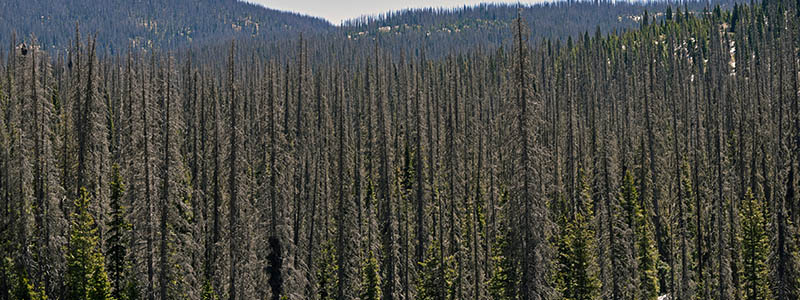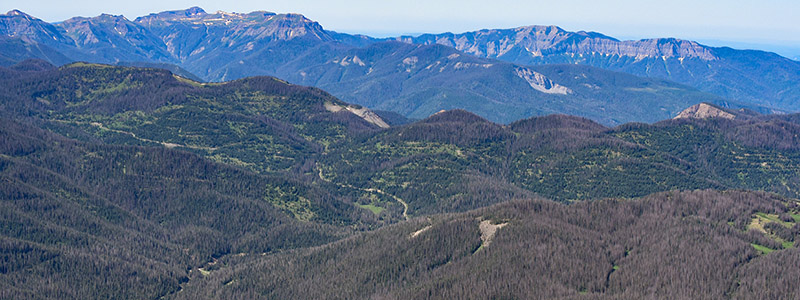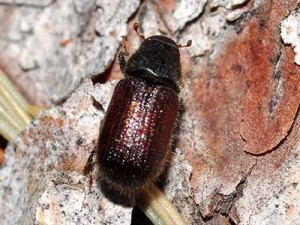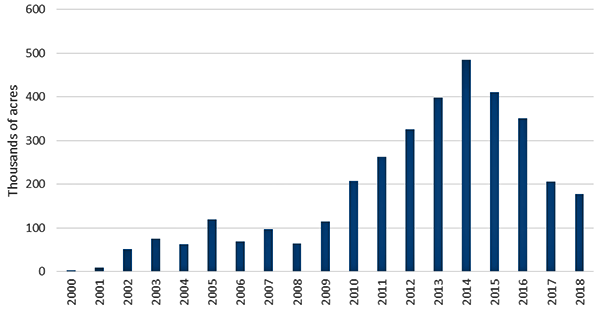Spruce Beetle
The spruce beetle has caused extensive tree damage to all species of spruce throughout the West.




Spruce beetles (Dendroctonus rufipennis) are native bark beetles that infest Engelmann spruce (Picea engelmannii) and occasionally Colorado blue spruce (P. pungens) in high elevation forests in Colorado. The spruce beetle typically completes a generation in one to three years, with a two-year life cycle being the most common in spruce trees growing above 9,000 feet. Adults fly to seek new hosts in late May through July, preferring large diameter trees until they are depleted from the forest.
Signs & Symptoms

Photo: William M. Ciesla
Needles on infested trees may turn a pale yellowish-green color and tend to drop to the ground after high winds, but rarely turn rust colored on the tree. Needles typically drop from branches the second summer after the tree has been infested. Boring dust, produced when beetles bore new entry holes, may accumulate in bark crevices and around the base of the tree.
Streams of resin along the main trunk are often associated with recently attacked trees.
Woodpecker damage, where the birds have stripped portions of the bark from infested trees in search of larvae (leaving accumulations of bark at the base of trees), is often an indicator of bark beetle presence. Exit holes on the bark surface may be seen after the adult beetles emerge from infested trees.
Annual Insect Activity
CSFS Forest Entomologist Dr. Dan West produces an Esri Story Map for the Annual Forest Health Report, which offers users an interactive way to find out about forest conditions and insect activity in their area.
Management Options
Large outbreaks of the spruce bark beetle are difficult to control. One of the best ways to mitigate the effects of spruce beetle outbreaks is to manage for overall forest health and resiliency. Thinning overly dense stands of trees to reduce competition and promote tree age and species diversity is the most successful forest management strategy to promote tree vigor. Removing downed spruce also may prevent the build-up of large local spruce beetle populations.
Options for management include:
- Remove infested trees and slash from thinning or pruning. Continual removal of wind-thrown Engelmann spruce, trees already infested by other insects and diseases, and excess numbers of older trees (as beetles most frequently attack the largest trees first) can be effective.
- Solar treatments can be used to reduce spruce beetle populations in small infested stands. These treatments involve felling infested trees and stacking cut logs in an area with full sun before covering them with clear plastic. The solar treatment of infested trees creates conditions unsuitable for survival of spruce beetles.
- Trap trees serve as traps for recently emerged, adult beetles. After the trap trees become infested with beetles, trees are removed and destroyed, usually during the fall or winter while all of the spruce beetles are still inside.
- Preventive insecticide sprays may prove effective in preventing spruce beetle infestation. Certain formulations of pyrethroids that are registered and tested for effectiveness are the primary preventive insecticidal sprays used to help reduce the likelihood of attacks on individual trees. The Colorado State Forest Service (CSFS) recommends spraying only high-value trees, such as those near homes, businesses or recreation sites. Follow the label of any chosen product.
- Hanging pheromone packets containing Methylcyclohexanone (MCH) may disrupt the attraction of incoming beetles and can be used to reduce attacks on spruce trees where no other management options are effective (e.g., in close proximity to water, near structures where the overspray of preventive insecticides may be undesirable.)
Publications
2018 Highlights
In 2018, severe outbreaks continued in portions of the San Juan Mountains, West Elk Mountains and Sawatch Range; the southern reaches of the Sangre de Cristo Mountains through the Culebra Range; and portions of north-central Colorado west of the Continental Divide, in and around Rocky Mountain National Park in Grand and Larimer counties.
Susceptible contiguous Engelmann spruce forests exist between expanding outbreaks in the northern and central portions of the state, indicating that the spruce beetle has the potential to affect new areas in the upcoming year.
- Spruce beetle has affected 1.84 million cumulative acres in Colorado from 1996 through 2018.
- Although some acres are more intensely affected than others, approximately 40 percent of the state’s spruce-fir forest ecosystems have been affected since 2000.
- 178,000 actively affected acres of Engelmann spruce forest were observed in 2018, compared with 206,000 acres in 2017.
- 59,000 “new,” or previously unaffected, acres were detected statewide in 2018, compared to 67,000 “new” acres in 2017.
Forested Acreage Affected by Spruce Beetle in Colorado, 1996-2018


